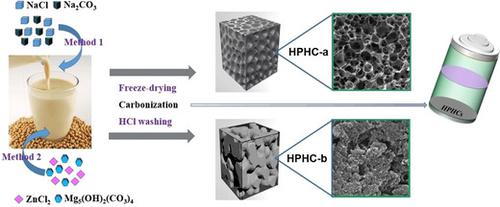当前位置:
X-MOL 学术
›
Chemistryopen
›
论文详情
Our official English website, www.x-mol.net, welcomes your
feedback! (Note: you will need to create a separate account there.)
Dual-Templating Approaches to Soybeans Milk-Derived Hierarchically Porous Heteroatom-Doped Carbon Materials for Lithium-Ion Batteries.
ChemistryOpen ( IF 2.5 ) Pub Date : 2020-05-12 , DOI: 10.1002/open.202000081 Peng Yan 1 , Huaibo Ye 1 , Yang Han 1 , Jingjing Wang 1 , Fenfen Zheng 1 , Weiwei Xiong 1 , Hongxun Yang 1 , Junhao Zhang 1 , Aihua Yuan 1 , Xingcai Wu 2
ChemistryOpen ( IF 2.5 ) Pub Date : 2020-05-12 , DOI: 10.1002/open.202000081 Peng Yan 1 , Huaibo Ye 1 , Yang Han 1 , Jingjing Wang 1 , Fenfen Zheng 1 , Weiwei Xiong 1 , Hongxun Yang 1 , Junhao Zhang 1 , Aihua Yuan 1 , Xingcai Wu 2
Affiliation

|
Biomass derived carbon materials are widely available, cheap and abundant resources. The application of these materials as electrodes for rechargeable batteries shows great promise. To further explore their applications in energy storage fields, the structural design of these materials has been investigated. Hierarchical porous heteroatom‐doped carbon materials (HPHCs) with open three‐dimensional (3D) nanostructure have been considered as highly efficient energy storage materials. In this work, biomass soybean milk is chosen as the precursor to construct N, O co‐doped interconnected 3D porous carbon framework via two approaches by using soluble salts (NaCl/Na2CO3 and ZnCl2/Mg5(OH)2(CO3)4, respectively) as hard templates. The electrochemical results reveal that these structures were able to provide a stable cycling performance (710 mAh ⋅ g−1 at 0.1 A ⋅ g−1 after 300 cycles for HPHC‐a, and 610 mAh ⋅ g−1 at 0.1 A ⋅ g−1 after 200 cycles for HPHC‐b) in Li‐ion battery and Na‐ion storage (210 mAh ⋅ g−1 at 0.1 A ⋅ g−1 after 900 cycles for HPHC‐a) as anodes materials, respectively. Further comparative studies showed that these improvements in HPHC‐a performance were mainly due to the honeycomb‐like structure containing graphene‐like nanosheets and high nitrogen content in the porous structures. This work provides new approaches for the preparation of hierarchically structured heteroatom‐doped carbon materials by pyrolysis of other biomass precursors and promotes the applications of carbon materials in energy storage fields.
中文翻译:

用于锂离子电池的豆奶衍生的分级多孔杂原子掺杂碳材料的双模板方法。
生物质碳材料来源广泛、价格低廉、资源丰富。这些材料作为可充电电池电极的应用显示出巨大的前景。为了进一步探索它们在储能领域的应用,对这些材料的结构设计进行了研究。具有开放三维(3D)纳米结构的多级多孔杂原子掺杂碳材料(HPHC)被认为是高效的储能材料。在这项工作中,选择生物质豆浆作为前驱体,通过使用可溶性盐(NaCl/Na 2 CO 3和 ZnCl 2 /Mg 5 (OH) 2 )两种方法构建N、O共掺杂互连3D多孔碳框架( CO 3 ) 4分别作为硬模板。电化学结果表明,这些结构能够提供稳定的循环性能(HPHC-a 循环 300 次后,在0.1 A ⋅ g −1下为 710 mAh ⋅ g −1 ,在 0.1 A ⋅ g −1下为 610 mAh ⋅ g −1分别以锂离子电池和钠离子存储(HPHC-a 900 次循环后 900 次循环后 210 mAh ⋅ g -1,0.1 A ⋅ g -1)作为阳极材料,HPHC-b 200 次循环后为1 。进一步的比较研究表明,HPHC-a性能的这些改进主要归因于含有类石墨烯纳米片的蜂窝状结构和多孔结构中的高氮含量。该工作为通过热解其他生物质前驱体制备分级结构杂原子掺杂碳材料提供了新的方法,并促进了碳材料在储能领域的应用。
更新日期:2020-05-12
中文翻译:

用于锂离子电池的豆奶衍生的分级多孔杂原子掺杂碳材料的双模板方法。
生物质碳材料来源广泛、价格低廉、资源丰富。这些材料作为可充电电池电极的应用显示出巨大的前景。为了进一步探索它们在储能领域的应用,对这些材料的结构设计进行了研究。具有开放三维(3D)纳米结构的多级多孔杂原子掺杂碳材料(HPHC)被认为是高效的储能材料。在这项工作中,选择生物质豆浆作为前驱体,通过使用可溶性盐(NaCl/Na 2 CO 3和 ZnCl 2 /Mg 5 (OH) 2 )两种方法构建N、O共掺杂互连3D多孔碳框架( CO 3 ) 4分别作为硬模板。电化学结果表明,这些结构能够提供稳定的循环性能(HPHC-a 循环 300 次后,在0.1 A ⋅ g −1下为 710 mAh ⋅ g −1 ,在 0.1 A ⋅ g −1下为 610 mAh ⋅ g −1分别以锂离子电池和钠离子存储(HPHC-a 900 次循环后 900 次循环后 210 mAh ⋅ g -1,0.1 A ⋅ g -1)作为阳极材料,HPHC-b 200 次循环后为1 。进一步的比较研究表明,HPHC-a性能的这些改进主要归因于含有类石墨烯纳米片的蜂窝状结构和多孔结构中的高氮含量。该工作为通过热解其他生物质前驱体制备分级结构杂原子掺杂碳材料提供了新的方法,并促进了碳材料在储能领域的应用。











































 京公网安备 11010802027423号
京公网安备 11010802027423号